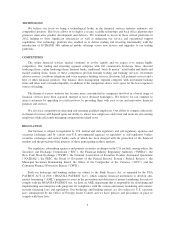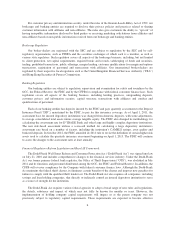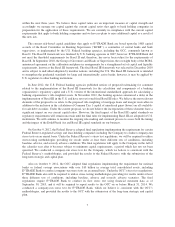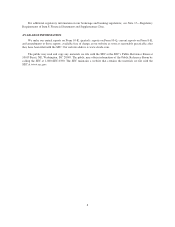eTrade 2012 Annual Report Download - page 18
Download and view the complete annual report
Please find page 18 of the 2012 eTrade annual report below. You can navigate through the pages in the report by either clicking on the pages listed below, or by using the keyword search tool below to find specific information within the annual report.As a result of the Public Equity Offering, the Debt Exchange and related transactions in 2009, we believe that we
experienced an “ownership change” for tax purposes that could cause us to permanently lose a significant
portion of our U.S. federal and state deferred tax assets.
As a result of the Public Equity Offering, the Debt Exchange and related transactions in 2009, we believe
that we experienced an “ownership change” as defined under Section 382 of the Internal Revenue Code of 1986,
as amended (“Section 382”) (which is generally a greater than 50 percentage point increase by certain “5%
shareholders” over a rolling three year period). Section 382 imposes an annual limitation on the utilization of
deferred tax assets, such as net operating loss carry forwards and other tax attributes, once an ownership change
has occurred. Depending on the size of the annual limitation (which is in part a function of our market
capitalization at the time of the ownership change) and the remaining carry forward period of the tax assets (U.S.
federal net operating losses generally may be carried forward for a period of 20 years), we could realize a
permanent loss of a portion of our U.S. federal and state deferred tax assets and certain built-in losses that have
not been recognized for tax purposes. We believe the tax ownership change will extend the period of time it will
take to fully utilize our pre-ownership change net operating losses (“NOLs”), but will not limit the total amount
of pre-ownership change federal NOLs we can utilize. This is a complex analysis and requires the Company to
make certain judgments in determining the annual limitation. As a result, it is possible that we could ultimately
lose a significant portion of deferred tax assets, which could have a material adverse effect on our results of
operations and financial condition.
Risks Relating to the Regulation of Our Business
We are subject to extensive government regulation, including banking and securities rules and regulations,
which could restrict our business practices.
The securities and banking industries are subject to extensive regulation. All of our broker-dealer
subsidiaries have to comply with many laws and rules, including rules relating to sales practices and the
suitability of recommendations to customers, possession and control of customer funds and securities, margin
lending, execution and settlement of transactions and anti-money laundering. We are also subject to additional
laws and rules as a result of our market maker operations.
Similarly, E*TRADE Financial Corporation and ETB Holdings, Inc., as savings and loan holding
companies, and E*TRADE Bank and E*TRADE Savings Bank, as federally chartered savings banks, are subject
to extensive regulation, supervision and examination by the OCC and the Federal Reserve (including pursuant to
the terms of the memoranda of understanding that E*TRADE Financial Corporation entered into with the Federal
Reserve and that E*TRADE Bank entered into with the OCC) and, in the case of the savings banks, also the
FDIC. Such regulation covers all banking business, including lending practices, safeguarding deposits, capital
structure, recordkeeping, transactions with affiliates and conduct and qualifications of personnel.
Recently enacted regulatory reform legislation may have a material impact on our operations. In addition, if we
are unable to meet these new requirements, we could face negative regulatory consequences, which would have a
material negative effect on our business.
On July 21, 2010, the President signed into law the Dodd-Frank Act. This law contains various provisions
designed to enhance financial stability and to reduce the likelihood of another financial crisis and significantly
changed the bank regulatory structure for our Company and its thrift subsidiaries. Portions of the Dodd-Frank
Act were effective immediately, but many provisions will only be effective after the adoption of implementing
regulations, which have been delayed in numerous cases. The key effects of the Dodd-Frank Act, when fully
implemented, on our business are:
• changes to the thrift supervisory structure;
• changes to regulatory capital requirements;
15
























